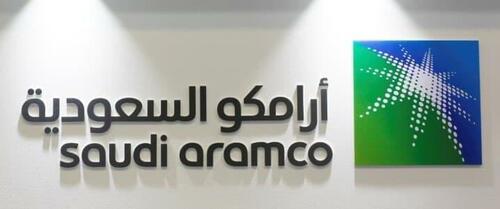By Alex Kimani of OilPrice.com
Last week, Saudi Arabia’s energy giant Saudi Aramco (ARMCO) confirmed in a filing with the Saudi Exchange plans to sell shares in the state-owned oil company to help the kingdom fund plans to diversify the economy. Well, the sale took place on Sunday and was a resounding success with US$12 billion share sale sold out shortly after the deal opened. The deal offered ~1.545B Aramco shares, or ~0.64% of the company, within the price range of 26.70 riyals to 29 riyals. Buyers of the shares will be looking to cash in on an upcoming ~$124 billion annual payout that Bloomberg Intelligence estimates will give the shares a juicy dividend yield of 6.6%.
Although details of the split between local and foreign shareholders are yet to emerge, industry pundits will no doubt be eagerly waiting for the release in a bid to gauge foreign interest in Aramco’s assets. Foreign investors largely sat out the company’s 2019 initial public offering (IPO), with investors concerned about the steep valuation of the shares. ARMCO stock has plunged 14% in the year-to-date to give the company a valuation of $1.8 trillion with daily production estimated at 9.3 million barrels of oil equivalent (boe). For some perspective, America’s largest energy company Exxon Mobil (NYSE:XOM) has a market cap just a quarter of Aramco’s ($451B) despite its daily production clocking in at more than 40% of Aramco’s (3.8M boe per day).
Aramco’s share sale comes at a time when oil prices remain depressed mainly due to concerns about weak global demand. Brent crude for July delivery was quoted at $77.50 per barrel in Tuesday's intraday session, a level they last sunk to in early February. The oil price selloff is a serious blow to Saudi Arabia considering that the IMF estimates that Riyadh requires an average oil price of $96.20 a barrel to balance its budget, assuming it holds crude output steady near 9.3 million barrels a day this year.
Saudi Arabia’s Non-Oil Revenue Soars
Luckily for Saudi Arabia, low oil prices will not affect the economy nearly as much as they did a decade ago. In recent years, the largest economy in the Arab world has sought to diversify in a bid to cushion itself against wild oil price swings. Three years ago, Saudi Arabia's Crown Prince Mohammed bin Salman unveiled Saudi Vision 2030, the Kingdom’s roadmap for economic diversification, global engagement, and enhanced quality of life. Vision 2023 is all about diversifying Saudi Arabia’s economy and creating dynamic job opportunities for its citizens through privatization of state-owned assets, including partial IPO of Saudi Aramco; unlocking underdeveloped industries such as renewable energy, manufacturing and tourism and modernizing the curriculum and standards of Saudi educational institutions from childhood to higher learning.
Well, it appears that Saudi’s Vision 2030 is already bearing fruit: Saudi Arabia’s Ministry of Economy and Planning has revealed that non-oil revenues hit 50% of the Kingdom's gross domestic product (GDP) in 2023, the highest level ever.
Last year, Saudi Arabia’s non-oil economy was valued at 1.7 trillion Saudi Riyals (approximately 453 billion U.S. dollars) at constant prices, driven by steady growth in exports, investment and consumer spending. The Kingdom’s private-sector investments expanded 57% to reach a record high of 959 billion Saudi Riyals (254 billion dollars) while arts & entertainment and real service exports grew in triple-digits to the tune of 106% and 319%, respectively, reflecting the Kingdom’s transformation into a global destination for tourism and entertainment. Meanwhile, Saudi Arabia’s food sector recorded 77% growth; transport and storage services increased 29%, health and education recorded growth of 10.8% while, trade, restaurants and hotels grew 7%.
In the economic plan, Saudi Arabia has set a target to develop ~60 GW of renewable energy capacity by 2030, multiples higher than the current capacity of 2.8 GW. But make no mistake about it: Saudi Arabia has no plans to ditch its legacy fossil fuel business any time soon. Indeed, Saudi Aramco has unveiled plans to reach net-zero by 2050 without sacrificing oil and gas production. During a rare two-day visit by Fortune in early May, the world’s largest fossil fuel company lifted the curtain on dozens of research projects which the company believes will help it tackle climate change, even while pumping a mammoth 9 million barrels or so of oil a day. Aramco claims its tech breakthroughs have the potential to cut carbon emissions from each barrel of oil it produces by 15% by 2035, equivalent to 51.1 million tons of carbon a year.
“We don’t see any contradiction. Combating emissions from these conventional energy sources is a very viable option,” says Ashraf Al-Ghazzawi, executive vice president for strategy and corporate development.
“We need all sources of energy to meet the growth in demand, which is just tremendous in the developing world. The main pillar of our strategy and technology is efficiency and optimization of our existing production,” Ahmad Al-Khowaiter, Aramaco’s executive vice president for technology and innovation, told Fortune. According to Khowaiter, the company has tripled its research-and-development staff since 2010, and listed 1,033 patents with the U.S. patent office. Aramco now spends about $800 million a year on R&D, 60% of which is focused on “sustainability”.
